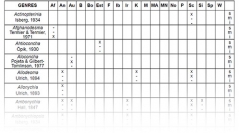

 Geodiversitas
25 (2) - Pages 243-259
Geodiversitas
25 (2) - Pages 243-259Data from 19 localities throughout the world yielding bivalves were analysed by means of cluster analysis. Due to the uncertainty about the completeness of the fossil record, genera restricted to a single locality at each of the three selected time intervals (Early, Middle, and Late Ordovician) were considered "exclusive" instead of "endemic". Results show very low similarity values, inclusive among localities belonging to the same biochore based on other marine benthic organisms (i.e. brachiopods). Moreover, the percentage of "exclusive" genera per locality is always very high at any time interval. Since the Early Palaeozoic bivalves are not biostratigraphically important, their real diversity has probably been underestimated. As a result, even if understanding of them has strongly increased in the last years, it is not still enough to give us an accurate picture of their generic distribution in space and time. However, the incompleteness of the fossil record itself does not explain this pattern of distribution. Most important factors could be related to biotic factors, such as the stenotopic nature of most of the shallow dwelling species, and the probably short-lived pelagic larval stage. The low percentage of shared genera among different localities seems to preclude the use of bivalves as relevant palaeobiogeographic indicators during the Ordovician.
Mollusca, Bivalvia, Ordovician, palaeogeography, palaeoecology